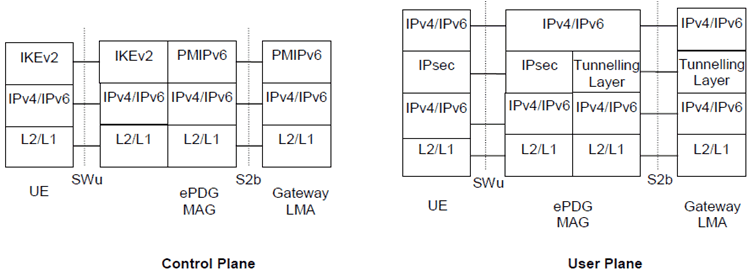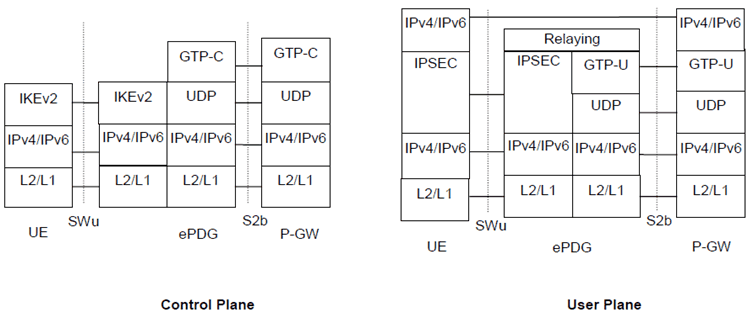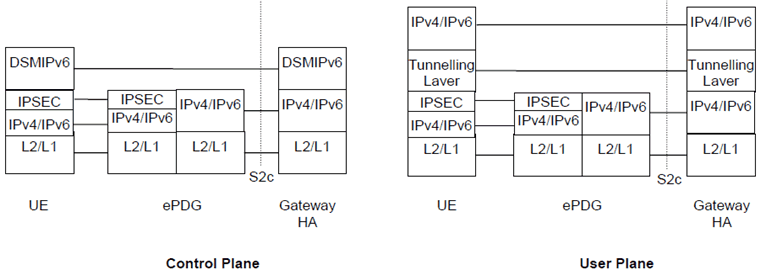Content for TS 23.402 Word version: 18.3.0
0…
4…
4.2…
4.2.2
4.2.3
4.3…
4.4…
4.5…
4.5.7…
4.6…
4.7…
4.7.2…
4.8…
4.8.2a…
4.9…
5…
5.2…
5.4…
5.5
5.6…
5.7…
5.8…
6…
6.2…
6.3
6.4…
6.4.3…
6.5…
6.6…
6.7…
6.8…
6.10…
6.13…
6.15…
7…
7.2…
7.3
7.4…
7.5…
7.6…
7.8…
7.10…
8…
8.2.1.2
8.2.1.3…
8.2.2
8.2.3…
8.2.6…
8.3…
8.4…
8.5…
9…
9.3…
9.4…
10…
13…
16…
16.1.2…
16.1.6…
16.2…
16.2.1a…
16.3…
16.4…
16.7…
16.8…
16.10…
17…
A…
C…
E…
7 Functional Description and Procedures for Un-trusted Non-3GPP IP Accesses
7.1 Control and User Plane Protocol Stacks
7.1.1 Protocol Options for S2b
7.1.2 Protocol Options for S2c over Un-trusted Non-3GPP IP Accesses
...
...
7 Functional Description and Procedures for Un-trusted Non-3GPP IP Accesses p. 157
7.1 Control and User Plane Protocol Stacks p. 157
7.1.1 Protocol Options for S2b p. 157
The following protocol may be supported on S2b:
- PMIPv6;
- GTP.

Figure 7.1.1-1: Protocols for MM control and user planes of S2b for the PMIPv6 option
(⇒ copy of original 3GPP image)
(⇒ copy of original 3GPP image)
Legend:
- According to terms defined in PMIPv6 specification, RFC 5213, the functional entities terminating both the control and user planes are denoted MAG in the non-3GPP IP access and LMA in the Gateway. LMA includes also the function of a Home Agent.
- The MM control plane stack is PMIPv6 (RFC 5213) over IPv6/IPv4.
- The user plane carries remote IPv4/v6 packets over either an IPv4 or an IPv6 transport network. Between the UE and the ePDG, packets are encapsulated using IPSEC RFC 3948.
- The tunnelling layer implements GRE encapsulation applicable for PMIPv6.
- IPv4/IPv6: This refers to network layer protocols. On the ePDG MAG user plane this includes termination of the UE-MAG IP messages that may be handled by the ePDG (e.g. DHCP) and forwarding of user plane IP packets between the UE-MAG point-to-point logical link and the S2b tunnel for the UE.

Figure 7.1.1-2: Protocols for MM control and user planes of S2b for the GTP option
(⇒ copy of original 3GPP image)
(⇒ copy of original 3GPP image)
Legend:
- GPRS Tunnelling Protocol for the control plane (GTP-C): This protocol tunnels signalling messages between the ePDG and the P-GW (S2b).
- GPRS Tunnelling Protocol for the user plane (GTP-U): This protocol tunnels user data between the ePDG and the P-GW in the backbone network. GTP shall encapsulate all end user IP packets.
- UDP/IP: These are the backbone network protocols used for routing user data and control signalling.
7.1.2 Protocol Options for S2c over Un-trusted Non-3GPP IP Accesses p. 158
The following protocols shall be supported for S2c over un-trusted non-3GPP IP accesses:
- DSMIPv6, with IPsec and IKEv2 used to secure mobility signalling, as specified in RFC 4877.

Figure 7.1.2-1: Protocols for MM control and user planes of S2c for the DSMIPv6 option
(⇒ copy of original 3GPP image)
(⇒ copy of original 3GPP image)
Legend:
- According to terms defined in DSMIPv6, RFC 5555, the functional entities terminating both the control and user planes are denoted MN (Mobile Node) in the UE, and HA (Home Agent) in the Gateway.
- The MM control plane stack is DSMIPv6, RFC 5555 over IPv6/IPv4.
- The user plane carries remote IPv4/v6 packets over either an IPv4 or an IPv6 transport network. Between the UE and the ePDG, packets are encapsulated using IPSEC RFC 3948.
- The tunnelling layer implements IP encapsulation applicable for MIPv6 as defined in DSMIPv6 RFC 5555. In some cases the tunnelling layer may be transparent.